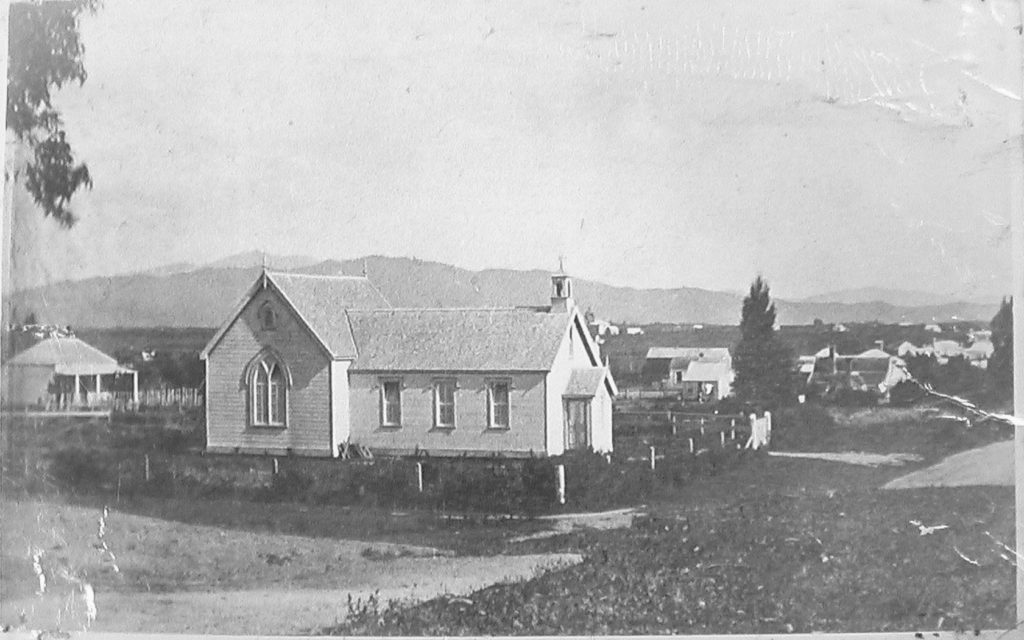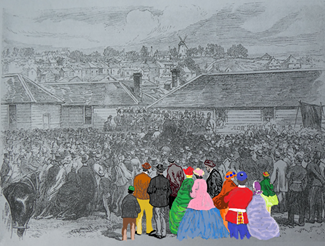
Who was “the Duchess” of Cambridge?
-
Image: Left – Stuart Newall’s house and former Post Office. Centre – Wesleyan Chapel. Right – the rear of the Duke of Cambridge Hotel. Background Pukekura and Maungatautari
Part 1 – A question
New Zealand Herald 2 February 1871 – When elections for the General Assembly were due, there was a meeting in Ngaruawahia where Mr Douglas proposed Captain McPherson, and Mr Robinson ‘better known as “the Duke” in Cambridge’ proposed Hugh Kirkwood.
So, if Andrew Robinson was “the Duke” who was “the Duchess”?
Andy Robinson was 28 years old, a miner in Dunedin, when he enlisted in the 3rd Waikato Regiment in 1863. His friend George Henry Heigen was also a miner. George was born in Germany; signed up in Sydney; sailed with his regiment to New Zealand on the ‘Charlotte Andrews’, which was welcomed with cheers and led by a band to the barracks in Auckland. The following June he was walking down the aisle with Mary Philomena Kirby. (He needed a special licence and changed his name to Hagin.)
1864
In Camp Cambridge officers were able to choose their sections and a savvy group of sergeants were already ensconced on Duke Street – the main street up from the wharf. Women and children joined their soldiering menfolk, and Andy, George and Mary planned their public house. The population was 843 men, 80 women and 198 children.
1865
As the surveyors sloshed about in the swamps, the men were balloted their farms and soon 350 men were struck off pay and deemed ‘settlers’. They and their families were still allowed to draw rations but had to be on alert and attend a drill every month. Twenty-two men deserted. Sixty substitutes arrived.
Andy had got himself into trouble with his superior when the rum rations turned out to be short. In June 1865 he was taken to Court in Auckland but it could not be proved if he was selling his private stock or the army’s rum. He was acquitted.
George and Andy opened their Duke of Cambridge Hotel, and Mary would have been in her element when they arranged the First Ball for all the officers of the garrison. (Her mother had a ladies and girls’ clothing store in Auckland.)
After supper Colonel Lyon and his new wife Sophia, opened the dancing and soon the crinolines and cravats were swishing around the room.
Then in Auckland on 14 September 1865 Andy married Agnes Theresa Kirby – George Hagin’s wife’s sister. Agnes was only sixteen – half Andy’s age, and they tied the knot securely with one ceremony at St Patrick’s Catholic Cathedral, and another at the Presbyterian Church.
They partied that night at Frank Quick’s Hotel in Auckland and a scoundrel stole Agnes’s gold watch, chain and locket. They got the watch and chain back but the locket was lost. The scoundrel got six month’s hard labour. Agnes joined her sister Mary at the Duke of Cambridge Hotel.
On Christmas Day, the sergeants still on pay shouted their contemporaries a dinner. The monthly parade took place on New Year’s Day, and Pukekura Redoubt arranged a sports day with rifle shooting, a greasy pole, catching the greasy pig, and foot and sack races. There was bobbing for buns for the children and a ladies race – but only Māori ladies entered.
Fashions of the day at the farewell to General Cameron, of the Colonial Defence Forces in Auckland 1 August 1865. (Illustrated London News 1865 x ‘Bold Century 1859 – 1959, NZ Insurance Co, Ltd.’.)
1866
Competition was appearing on the hotel horizon as Archie and brother Bill Clements built the Masonic Hotel, also on Duke Street.
Then in May, a little bundle of joy for Agnes and Andy Robinson when Mary Theresa Josephine was born – possibly a premmie-baby as sadly two days later she died of debility (weakness).
A couple of weeks later Andy and George dissolved their partnership and George and Mary went to Auckland and took over the New Caledonia Store. John and Robert Kirkwood built the Alpha Hotel on the top of the hill with accommodation and a place for the Alpha Lodge’s meetings.
Duke Street was still the main street. To the north of Andy and Agnes’s hotel, Jim McClellan the baker ‘fell off the wagon’ and died of alcohol poisoning, leaving a wife and three young children. Andy served on the Jury at the Inquest held in his hotel. Their neighbour to the west, Chas Baker sold half his acre section to Andy who gave it to the Wesleyans to build their chapel in Chapel Street.
Their neighbour to the nor’ west, Stuart Newall ran the post office from his house and built a boat to woo his sweetheart, Georgina Roberts – rowing her around The Lagoon. One day, when Stuart was out on the lake, Thorne Buckland was riding past and he stood up in his stirrups, waved his hat, and saluted with the cry, “Advance Cambridge”.
In the New Year of 1867 both Andy and Bob Kirkwood held sports for the children, and Andy and Agnes hosted another Ball.
6 July 1867 – “It’s a boy!” – William (for Andy’s father) John (for Agnes’ father).
Then there was the shout of “Gold” and the Thames Rush was on.
Next Christmas the Rifle Club and Oddfellows Lodge tried to out-do each other with balls at the Star Redoubt. And then there was a new Duke in town – Bob Kirkwood changed the name of his Alpha Hotel to the Duke of Edinburgh.
On New Year’s Eve, Andy and Agnes hosted another ball and gave away hats and caps as prizes for the children’s New Year sports.
On Sunday 8 March 1868, the first Wesleyan Chapel on the Waikato Circuit was opened in Cambridge.
April 1869 – another flurry of excitement as Agnes and Andy had a girl – Rosanna. And in May 1871 they welcomed Agnes Theresa Bella.
At the end of 1873 Andy Robinson sold his hotel business to William Walker but by the end of the next year he was back at the helm. There was another addition to the family with the arrival of Lucy Jane in 1874 – but sadly the death, of heart disease of Agnes Theresa Bella in November. At that time there was no doctor in Cambridge. William Cunningham had experience but no diploma.
1876
The Duke of Cambridge hotel was looking good. Rooms were Lofty – Well Ventilated – Clean and Comfortably Furnished. Private Rooms with en suite for families’ accommodation. Dining, Bar – with only the choicest of Wines, Ales and Spirits. Sample Rooms for Commercial Gentlemen, Good Stabling and Paddock Accommodation. Andy was the Proprietor.
But not for long. He died of kidney disease on 7 March 1876 aged 43 years. He was buried in the Cambridge Cemetery by Reverend Father Golden RC.
Agnes was distraught and left for the warm waters of the Waiwera Springs, but stopped with her Mum and Dad in Auckland. While there she was ‘seized with a fit’ [a stroke]. On 21 March, feeling worse than when she had left, and fretting for the children, she decided to return home. The train to Mercer was insufferable and she had to take a carriage to the steamboat. The shaft broke on the boat at Rangiriri and all passengers were transferred to another steamboat – the ‘Blue Nose’. It was towing a number of barges and Agnes became seriously ill. So they cast off the barges and sped towards Hamilton. But Agnes died before she reached medical assistance.
Dr Waddington, coroner at her Inquest, said Agnes had complained of shortness of breath and palpitation but he had not prescribed for her during the last twelve months. Cause of death was serious apoplexy. Agnes was 26 years old and left three children: William aged 9, Rosanna 7 and Lucy 2. The jury’s verdict – ‘died from natural causes.’ Agnes was also buried at the Cambridge Cemetery. There is no headstone.
Aunty Mary and Uncle George gathered up the children.
Part 2 – An error identified
Waikato Independent 14 May 1936. C W Vennell’s article ‘Early Cambridge The First Sixteen Years from ‘The Waikato Mail and Midland Counties Farmers’ Gazette,’ published at Cambridge on September 1st, 1880 (With the addition of a few details supplied by some of Cambridge’s present-day residents whose memories go a long way back to bring it up-to-date.)
‘Mr Andrew Robinson then built the first hotel in Duke Street, not far from the wharf. This was afterwards part of the Duke of Cambridge Hotel occupied by Mr Robert Kirkwood, who was commonly known to his contemporaries as “The Duke”.’
The Kirkwood brothers Hugh, John and Robert arrived in Cambridge with the Militia – noted as having a general store at the wharf. John and Bob enlisted as substitute soldiers in 1866.
Bob’s acre was on the corner of Victoria and Alpha Streets and this is where they built their Alpha Hotel. Bob continued as a storekeeper and later ran the hotel, changing the name to the Duke of Edinburgh.
The Hally family – mother Eliza, George, James, John and Jessie arrived in Cambridge about 1867. James bought Mr John’s store and brought it up from the wharf to the corner of Duke and Victoria Streets. Bob built his store next to their hotel then transferred his Duke of Edinburgh’s licence to Hugh Pearson. He went farming for seven years at Tamahere and returned to town to buy the Duke of Cambridge Hotel in 1879. He then married Jessie Hally on 15 September 1879 and they had two children – who did not marry. Bob died of cancer in 1898 and Jessie in 1935. They are both buried at the Cambridge Cemetery.
References – Nominal & Descriptive Roll 3rd Waikato Regiment x National Archives Wellington; Papers Past website National Library; Department of Internal Affairs BDMs
Written by Eris Parker, published in the Cambridge Historical Society Newsletter June 2025
Local historian and prolific writer Eris Parker was a foundation member of the Cambridge Writers Group in 1987. She began volunteering for the Cambridge Museum before being appointed curator from 1992 until 2013. In that time, she researched and wrote books and brochures and spoke many times to local groups and organisations. When her colleague Susan Hague launched the museum’s website, it was Eris who provided the research stories and data for all to access. In 2018, the Cambridge Historical Society granted Eris a Life Membership.

